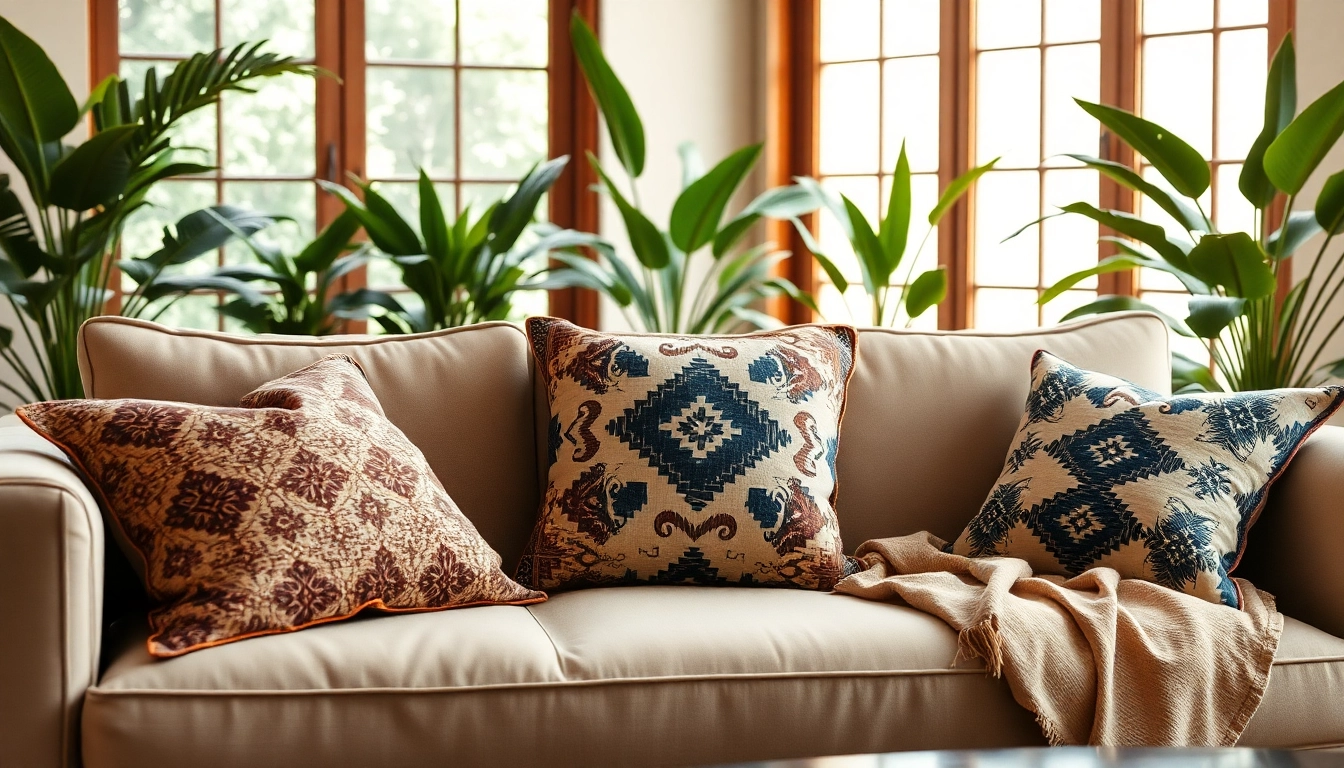Understanding Mudcloth: The Art and Culture Behind the Cushions
The History of Mudcloth in West Africa
Mudcloth, or bogolanfini, is a traditional fabric rooted deeply in the culture of West Africa, particularly among the Bamana people of Mali. Its history began centuries ago, originating from the need for functional yet decorative textiles. Associated with rituals and ceremonies, mudcloth is made from cotton fabric dyed with fermented mud, which imbues the cloth with earthy shades unique to its origins. Historically, the process was steeped in significance—craftswomen would create cloth as part of their cultural expressions, often portraying specific narratives through their intricate patterns and colors.
Craftsmanship and Techniques Used in Mudcloth Making
The craftsmanship behind mudcloth is as compelling as the fabric itself. The production involves a labor-intensive process that begins with cotton cultivation. After harvesting, the cotton is spun into thread and woven into cloth. The real magic happens during the dyeing process, which utilizes natural materials, such as tree bark and mud. The artisans apply diverse dyeing techniques, including resist dyeing, where certain areas of the cloth are treated to prevent the dye from penetrating, allowing for unique designs to emerge.
Symbolism and Meaning of Mudcloth Patterns
Each pattern and color used in mudcloth design holds significance. The symbols often narrate stories or signify status, prayers, and cultural heritage. For instance, a pattern featuring a repetitive geometric shape might represent unity and togetherness, while others may depict aspects of nature, fertility, and life cycles. This deep symbolism not only enhances the fabric’s aesthetic appeal but also its value as a storyteller, bridging generations and preserving cultural narratives.
Choosing the Perfect Mudcloth Cushion for Your Home
Varieties of Mudcloth Designs Available
When selecting mudcloth cushions, the design is critical to matching your home’s aesthetic. Mudcloth patterns come in a variety of styles ranging from bold geometric shapes to more intricate and elaborate motifs. Many cushions feature contrasting colors that can create striking visual elements in a room. Whether you prefer a subdued palette or vibrant, eye-catching designs, there is a mudcloth cushion that can enhance your space. As an example, cushions featuring dark brown against light beige can evoke a rustic charm, while bold colors like blue and yellow can invigorate a modern setup.
Size and Placement Considerations for Cushions
Size and placement are vital when choosing cushions, as they greatly influence your interior’s overall feel. Standard sizes for cushions range from 18×18 inches to 24×24 inches, depending on where you intend to place them. For instance, larger cushions make a statement on bigger sofas or beds, while smaller options suit accent chairs or decorative throws. Consider the layout of your living spaces: arrange cushions in groups for added comfort and aesthetic intrigue, mixing various sizes and patterns to create a dynamic look.
Color Palettes: Matching Mudcloth with Your Decor
Color coordination can seem daunting, but choosing mudcloth cushions can be simplified. If your space features warm tones, cushions with similar hues can create a sense of harmony and comfort. Conversely, opting for contrasting colors can add a modern flair to a neutral palette. For example, mudcloth cushions with earthy greens and browns can complement a rustic interior, while bright reds and deep blues can stand out beautifully in a minimalist room. Don’t hesitate to experiment; layout samples of fabrics against walls and furniture to see how various colors interact with each other in different lighting.
Caring for Your Mudcloth Cushions: Tips and Best Practices
Cleaning and Maintenance Techniques
To ensure the longevity of your mudcloth cushions, proper care is essential. Although mudcloth is durable, it should be cleaned wisely. For spot cleaning, gently dab the stain with a damp cloth using mild soap — avoid scrubbing to prevent damaging the fabric. For deeper cleans, hand washing in cold water is recommended. Always air dry your cushions to avoid shrinkage or loss of shape. Keeping your cushions away from direct sunlight can also help maintain the vibrancy of their colors.
Storage Solutions for Longevity of Fabric
When not in use, proper storage will preserve the quality of your mudcloth cushions. Store them in a cool, dry place to avoid moisture that can lead to mildew. Use breathable storage bags to protect against dust, and avoid compressing them too tightly to maintain their shape. Alternatively, rolling the cushions can help save space and prevent creasing.
Dealing with Common Issues: Stains and Wear
Stains and signs of wear are common, especially in frequently used cushions. For stubborn stains, consider consulting a professional cleaning service for advice specific to mudcloth. Additionally, rotating your cushions periodically can help evenly distribute wear and prevent one area from becoming overly worn. Refrain from using harsh chemicals that could degrade the natural fibers of the cloth. Regularly inspect for any signs of damage to catch any issues early on, allowing for timely repairs or replacements.
Styling Ideas: Integrating Mudcloth Cushions into Your Decor
Creating a Bohemian Vibe with Mudcloth Cushions
Mudcloth cushions are synonymous with bohemian style. To capitalize on this aesthetic, consider layering cushions of varying sizes and textures to create a warm and inviting atmosphere. Mix mudcloth with other ethnic fabrics, such as kilim or ikat, for a rich, eclectic look. Incorporating ornamental accessories like rattan furniture or wooden elements can subtly tie together the natural theme of the decor.
Balancing Modern and Traditional Design Elements
Combining modern and traditional styles can result in stunning decor that feels both timeless and contemporary. Select mudcloth cushions featuring minimalistic patterns to incorporate into sleek modern designs—consider pairing these cushions with a contemporary sofa or chair. This interplay creates balance, drawing on the rich historical context of mudcloth while allowing modern designs to shine. Use metallic accents and streamlined furniture to further enhance this balance.
Layering Fabrics: Combining with Other Textiles
Layering is a design technique that can elevate your decor to new heights. Pair mudcloth cushions with other textiles, such as velvet or linen, to introduce depth and interest. For example, using a mudcloth cushion alongside a soft faux fur throw can create an inviting and tactile space. Don’t shy away from textures; combining various fabrics can invoke a sensory experience, making your living space feel more dynamic and cozy.
Where to Buy Authentic Mudcloth Cushions Online
Navigating Online Stores: What to Look For
When purchasing mudcloth cushions, authenticity is paramount. Look for retailers that provide information about the origins and crafting process of their products. Reading reviews from other buyers can also provide insights into the quality and durability of the cushions. For quality options, consider checking specialized stores like https://labboho.com/collections/mudclothcushions, which focus on authentic African decor and artisanal craftsmanship.
Price Comparisons and Value Considerations
Prices for mudcloth cushions can vary significantly based on factors such as size, complexity of the design, and sourcing methods. Generally, authentic handmade cushions will be priced higher due to the labor-intensive craftsmanship involved. It’s essential to consider the overall value, taking into account not only the aesthetic appeal but also the quality and longevity of the product. Investing in high-quality pieces can pay off in terms of durability and style.
Ethical Sourcing: Supporting Artisans and Communities
Purchasing authentic mudcloth cushions is not just about decor; it’s also a means to support artisans and their communities. Ethically sourced products ensure that the artisans receive fair compensation for their work, which supports local economies and preserves traditional craft techniques. When you choose to buy from ethical sources, you’re helping to sustain the heritage and livelihoods of craftspeople around the world, making your home décor choices meaningful.



